
P8
**@
*********26.jpg” width=”640″ height=”426″ /> An Air Koryo Ilyushin IL-62 in Beijing, ready for boarding. Photo by Bernie Leighton.
To fly on an Ilyushin IL-62 in 2012 is not something many people would think of doing, let alone going to the lengths I did to enjoy the privilege.
On October 20, 2012 after months of planning, amounts of Euro cash that had bank-tellers convinced I was a spy; a lovely jaunt to Beijing on Air Macau and a visit to Datangshan, I was standing at the check in counter for Air Koryo in Terminal 2 at Beijing Capital International Airport (PEK). Oddly, and unfortunately for collectors of rare boarding passes, flights to Pyongyang are issued on Air China stock.
Chinese police, and politeness didn’t really allow me to capture the sight of the sheer amount of cargo the North Korean people were taking back but it was the contents I found more curious than the volume. A cursory search of the bindles and exposed boxes showed mostly flat-screen TVs and other completely civilian commercial goods.
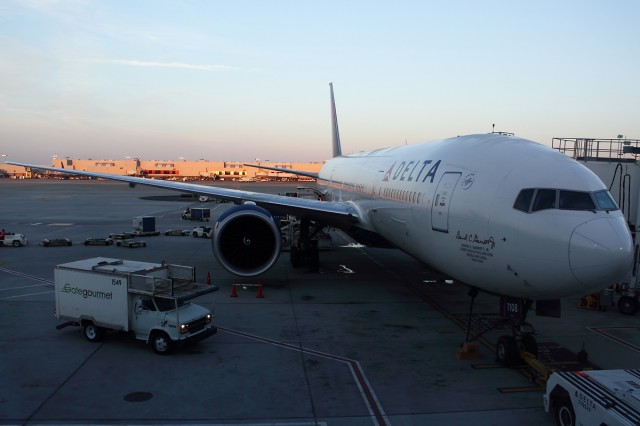
Delta Boeing 777-200LR in Atlanta. Notice the special signature on the nose. Photo by Brandon Farris.
I recently had the opportunity to fly from Atlanta (ATL) to Los Angeles (LAX) on Delta Air Lines flight 110, that was operated by a Boeing 777-232LR. Being the AvGeek that I am and having never flown on a 777 I just couldn’t turn this opportunity down.
I hopped on a red eye out of Seattle (SEA) that got into ATL at 05:30am giving me nearly 3 hours for my connection. I believe it literally took me maybe 20 minutes to get from where my SEA plane was parked in the B gates to gate F4 where I lay eyes on N708DN, a 2009 777-232LR that would be my ride back to the west coast. This aircraft is dedicated (with a special logo on the nose) to Delta’s former CEO David C. Garrett Jr who served for the airline from 1978-1987.
Being that I was at the airport so earl,y not many shops were open yet, so I mingled around the terminal where I saw a Boeing 767-432 arrive from Rio as DL60 and an Airbus A330-323 pushed back at 06:10am and depart as DL8860 to Saint Martin which was a surprise.
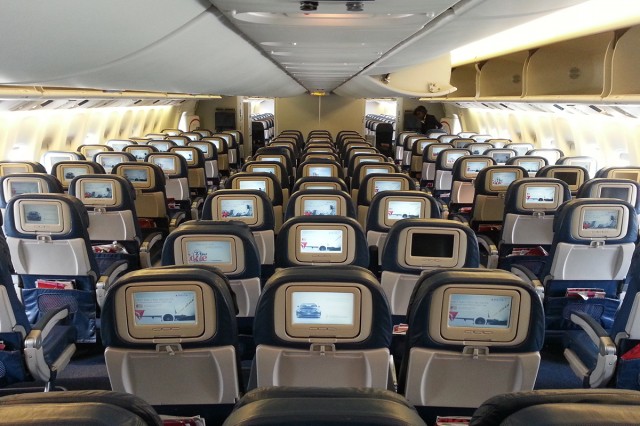
Delta configures their 777’s in a 3-3-3 layout. Photo by Brandon Farris.
Gate agents finally arrived around 07:00AM for our 08:10AM departure, at this point I was assigned 53E which is literally middle middle on this aircraft as it is a 3-3-3 configuration in the coach cabin.
It finally approached time to board, but were told that there was a slight delay with the cleaning crews onboard the aircraft and boarding would begin as soon as possible. Once boarding began I waited until the very end to get on since all I had was a backpack and wouldn’t require any overhead space.
Walking down the jetway the excitement began to settle in that I was about to step foot on my first ever 777 flight even if it was domestic, it is still a 777. By the time I boarded near the end, it didn’t take very long to get to my seat near the very back of the aircraft.
The time was now 0819 and our push-back began, only 9 minutes late so not too shabby. This was the part that I was most looking forward to; that howling growl start of those amazing General Electric GE-90’s as they spool up and come to life. I heard the first one start and it was like music to my hears. I know that I had the biggest and dorkiest smile/look on my face like a 5 year old. Yes I am in love with that howl!
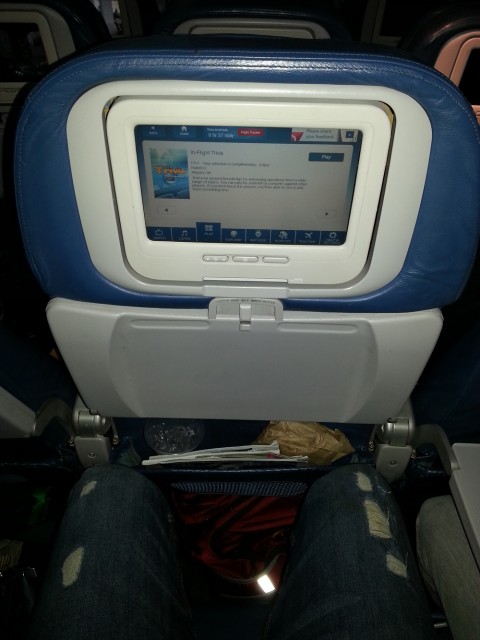
Delta’s Economy in-flight entertainment. Photo by Brandon Farris.
Following the push-back, we begin our taxi out. The pilot came on the intercom and alerted us that we are number five for departure, 19 minutes after departing the gate the aircraft begins to turn on the runway. I was ready to feel the full 220,000lbs of thrust but since we were so light with only going to LAX the pilots really didn’t seem to throw the throttle that high. It didn’t seem very long for us to climb to our cruise altitude of FL400 as we headed west. I must admit that this was one of the quietest cabins I have flown on at cruise.
Now, I had the opportunity to check out the seats. They seemed very wide which I absolutely loved but at the same time each row is extremely narrow to where my knees were almost in the seat in front of me (I am 6’0″). I couldn’t imagine if someone had been sitting in front of me and reclining the seat. It would have crippled my space, in a long haul flight I definitely would consider upgrading to the front cabin if possible, but luckily this was a shorter flight.
The lack of leg space however was made up for with the ability to plug my phone in to charge and a seatback TV which had a very wide array of movies to choose from including ones that had just come out on DVD last week like Life of Pi, to classics like The Goonies.
I choose Lincoln, but since I was so tired, I fell asleep about 20 minutes into it and I actually took a nap for about 3 hours. When I woke up, the cabin crew was coming through with a final beverage service. As a part of the service, they offered three choices for snacks: pretzels, peanuts or the infamous biscoff cookies. This was a welcome change as I am just used to the standard AM or PM snack depending on when my flight was.
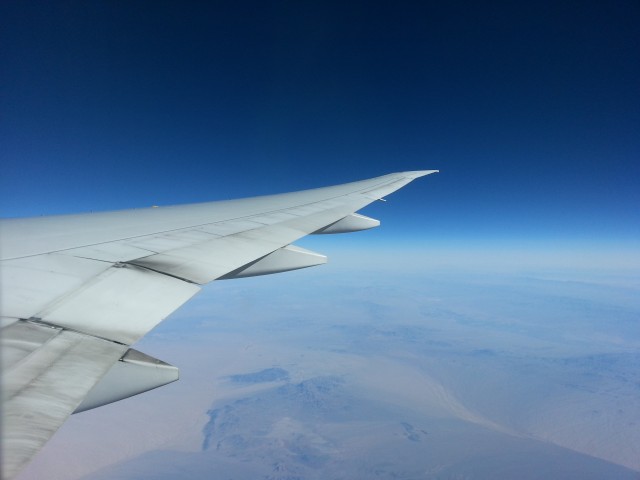
Flying on the 777. Photo by Brandon Farris.
At this point we were now about 40 minutes out from LA so I decided to get up and stretch a little and see if I could find a window to peak out somewhere and at least get a couple of pictures and was lucky to find that the cabin doors all have windows and was able to snap away for a couple of minutes. I also took this opportunity to visit the lav to find it was surprisingly very spacious.
But now it was time for me to return to my seat as we began our descent into LAX and was a fairly smooth approach. We landed on 25L and the pilots brought us in very gently before I was able to hear the roar of that GE-90 as the thrust reversers were kicked in. Following a short taxi we parked at the gate at 0957, three minutes early even after the late push.
Deplaning was brief, only being about 15 minutes from the back of the plane. I had the opportunity to talk to the pilots and was invited to make a brief visit to the flight deck before finally leaving the aircraft.
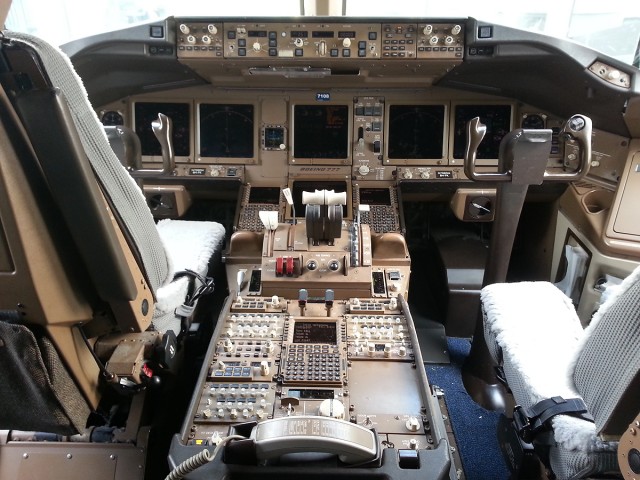
Flight deck of the 777. Photo by Brandon Farris.
Overall for this being my first time ever flying on Delta and the Boeing 777 I was extremely impressed on both fronts. The gate agents were extremely friendly which can be rare to find, especially at 0600 and 0700 in the morning. The inflight crew was great and was willing to answer any questions I had. It was nice to see such happy and helpful employees working for Delta after I have heard mixed reviews. Now to try and test out the 777 on a longer flight.
NOTE: Brandon covered the cost of this flight on his own and it was not paid for by Delta.
 |
This story written by…Brandon Farris, Correspondent. Brandon is an avid aviation geek based in Seattle. He got started in Photography and Reporting back in 2010. He loves to travel where ever he has to to cover the story and try to get the best darn shot possible.
@BrandonsBlog | RightStuffPhotography | Flickr |
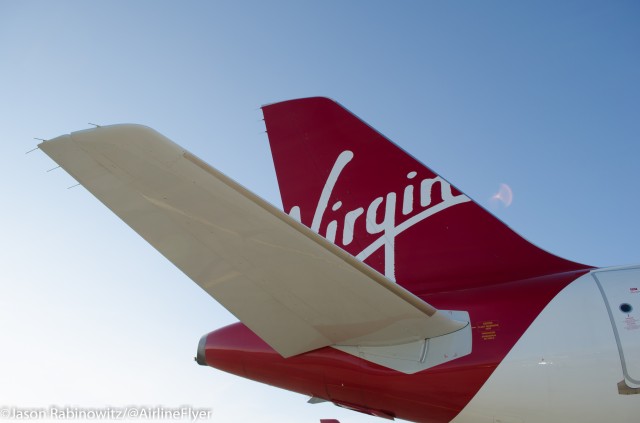
I talk about airlines and airplanes a lot; it’s a part of who I am. Fairly often, my conversations about such topics end up on Virgin America. At this point, I am forced to divulge the fact that I had never been on Virgin America, a statement which is often met with a blank stare followed by the response, ’œreally?’
Most of my domestic flights are on JetBlue and Delta, simply because of their much larger route network out of New York, where I am based. When I finally had the opportunity to give Virgin America a try, I immediately jumped at the chance. I flew from New York’s John F. Kennedy International (JFK) to San Francisco (SFO) and back in 12 hours as part of a media event, so travel was paid for by the airline (note: the airline paid for my trip, but all opinions are my own).
At JFK, Virgin America is based out of Terminal 4, which mainly houses international carriers. Virgins gates are in the A concourse, which is simply not where you want to be. With extremely limited restaurant and shopping options there, you will want to spend as little time as possible at the gate. Thankfully, Terminal 4 is undergoing a massive renovation which will remedy this issue. The terminal is in the process of unifying the two security checkpoints, and when complete, passengers will have access to a markedly wider selection of restaurants and shopping.
Virgin Americas gate at JFK T4 does not stand out in any way over any other domestic airline. There is no fancy seating, no nice lighting, and not so much as power outlet in sight. However, the instant you board the aircraft, things immediately start to change.
Most passengers will quickly notice the colorful mood lighting, which is a great upgrade from the typical dim white fluorescent tube lighting. At first it might appear the lighting is all LED, like we are seeing in new Boeing interiors, but it is actually a combination of fluorescent tubes and white LEDs with a color gel on them.
It’s warm, inviting, and just overall pleasant. Once settled, I found the seat to be quite comfy. The adjustable head rest is a great addition to the black leather seat. At 6’2’’, legroom was not an issue, as I had room to stretch, something becoming increasingly rare in economy.
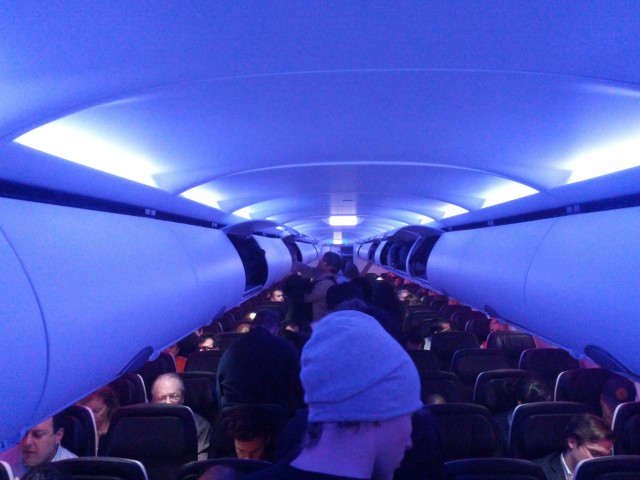
Virgin America features one of the most advanced in-flight entertainment systems I have ever used, and I took this opportunity to put it to the test. The system, called RED, features movies and TV shows on demand, live satellite TV, food and drink ordering, and other information features. What I liked most about the system was how responsive it was. I never encountered any lag in the system, which makes the user experience quite enjoyable. I was thankful that the live TV was free, as I found the other selections a bit too expensive for my taste. The satellite TV selection is limited to 18 channels compared to 36 on JetBlue, and certain channels did not work, but I was always able to find something to watch.
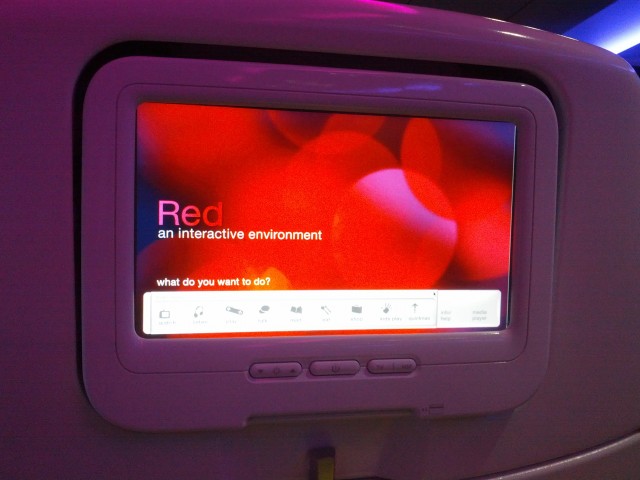
One thing that did irk me about the entertainment system was that there seemed be a lot of features that either didn’t work, or weren’t yet available. For instance, on the main menu there is a button labeled ’œread,’ but when clicked, a message told me that the feature is not yet available. A feature that is not yet activated should not be displayed as an option to the passenger.
I was able to follow up with Virgin American and they explained to AirlineReporter.com that they are, replacing the Read section with an Info Section, “that includes static content that will be updated every six weeks, but that relates to travel, destination and other info that is more ‘evergreen’ and that fits better with what guests want to engage with in-flight.”
Similarly, I had some issues with the program guide for the live TV. I would click on it and an error message would appear. That must have just been an isolated instance. Additionally, I would like if some on-screen reference was made to the tethered remote in the armrest. Had the passenger next to me not removed it first, I probably would never had known it could be moved.
My favorite part of the Virgin America experience was probably the in-flight ordering process. Virgin has done away with the traditional cart down the aisle system, and instead passengers order what they want through their screen and a flight attendant delivers it. I was extremely impressed at how simple the ordering process was, and how quickly items were delivered. If I could change one thing, it would be the inclusion of any free food option, even if just a small bag of chips. All food is purchase only in economy, no freebies except for drinks.
Once arriving to SFO, I made my way to my hotel and did not really check out the terminal. The following day, I made an effort to arrive at SFO early in the morning and was relieved to discover how beautiful Virgin America’s terminal was. Wide open spaces, bright, restaurant choices to satisfy even the most picky of eaters. This terminal clearly reflected Virgin’s attitude.
Unlike the terminal at JFK, SFO features lovely seating areas, classy furniture, free wifi and power outlets everywhere. These upgrades go a long way when it comes to unwinding after passing through security, and I wish any of these features were present at JFK.
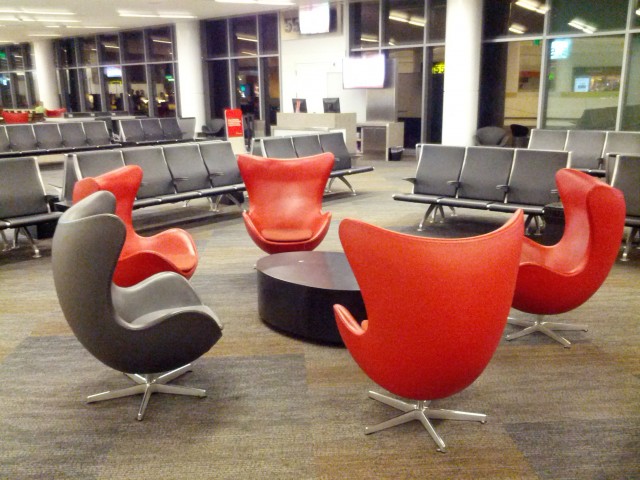
Now that I have finally flown Virgin America, I can give an honest opinion of this high-tech, feature packed airline. While the airline did not disappoint, I’m not sure I would pay a premium over other airlines such as JetBlue for the privilege. The entertainment system may be more advanced and the mood lighting may create a brighter atmosphere, but overall, I felt the overall experience was different, but comparable. However, when compared to some legacy carriers that fly the route, I would absolutely consider upgrading to Virgin America.
The flight from SFO to JFK was a special media flight to fly the San Fransisco Giants World Championship Trophy to New York… stay tuned.
 |
This story written by… Jason Rabinowitz, Correspondent.
Jason is a New York City native who has grown up in the shadow of JFK International Airport. A true “avgeek”, he enjoys plane spotting and photography, as well taking any opportunity he can get to fly on an aircraft.
@AirlineFyer | FaceBook | |
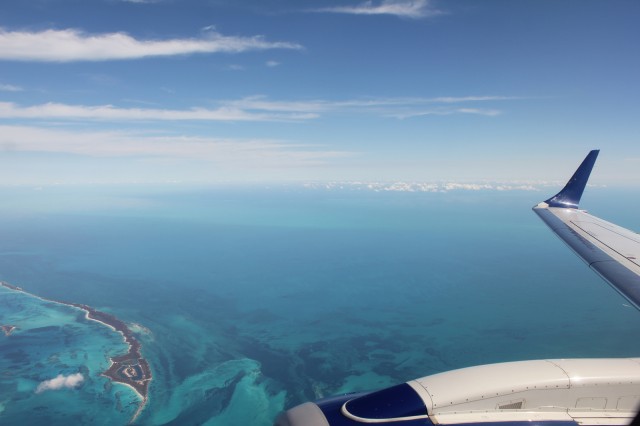
The Bahamas puts the “blue” into JetBlue.
JETBLUE ECONOMY REVIEW BASICS:
Airline: JetBlue
Aircraft: Embraer E-190 N317JB, Deja Blue
Departed: Lynden Pindling International Airport (NAS)
Arrived: Boston Logan International Airport (BOS)
Stops: None
Class: Economy
Seat: 7D
Length: 3hrs
Cheers: Great little bonuses: full soda can, free TV, lots of snacks and one free checked bag.
Jeers: Wish there was some Wi-Fi — it is coming soon.
Bottom Line: JetBlue does not feel like a low-cost airline
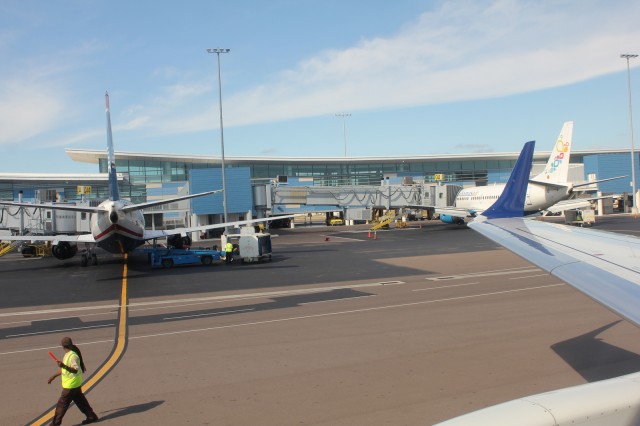
Taxiing at NAS towards the runway. There is a Bahamasair Boeing 737-500 in the background.
FULL JETBLUE ECONOMY REVIEW:
Being based in Seattle, I do not get the opportunity to fly JetBlue very often. It has been a few years since I have experienced one of their flights and I was excited to see I was flying them home after a recent press trip to The Bahamas (note: The Bahamas Tourism paid for my ticket on JetBlue).
I have only flown the E-190 once before in a business class flight on Air Canada from Toronto to Seattle. I was impressed with the larger seats up front on my Air Canada flight, but I have been wanting to try out what it is like sitting in the back of the E-190 and this flight gave me the opportunity.
JetBlue E190s are configured with 32″ seat pitch, but if that is not enough for you, then you can upgrade to Even More Space, which gives you (wait for it…) even more space. Rows one, 12, 13 and 14 offer 6-7 inches of additional space and give priority boarding for an extra charge. The aircraft is set up in a 2-2 layout with 100 seats — this means aisle and window seats for everyone.
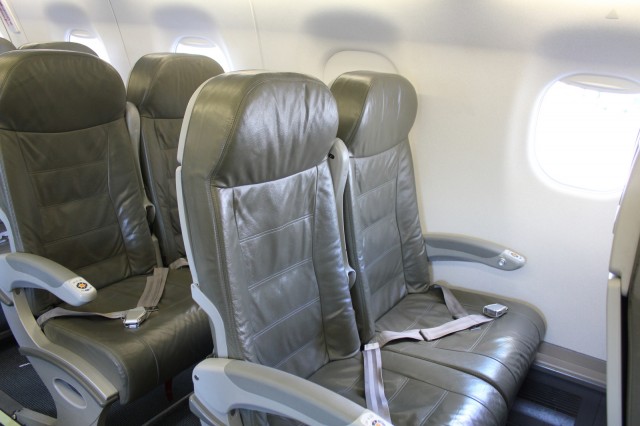
The E-190 provides a window or aisle seat for every passenger.
The flight was only about half full, so after allowing passengers with Even More Space seats and those who need additional assistance to board, everyone else was allowed to board in one group.
I normally try to take photos of the aircraft before I board, but NAS does not offer great photo angles from the airport. However, the photos after take-off more than make up for it.
The overhead bins on the E-190 are not too large, so I planned ahead and checked my larger carry-on bag. Extra bonus: JetBlue allows you to check one bag for free. Was kind of a pain to haul my camera, laptop and chargers around Boston (where I had my layover), but I managed.
No matter what seat you are sitting in, you will get free TV with 37 channels of entertainment. There are also three additional channels that play movies and for international flights (which mine was), the movies are free. If you are on a domestic flight, the premium entertainment will cost you $5.99 to watch a movie. Make sure to bring your own headphones or purchase one for $2 once you board the aircraft, because the movies start shortly after leaving the gate. I made the mistake of waiting to buy after taking off and I missed 10 minutes of Batman: The Dark Knight (luckily I had seen it previously).
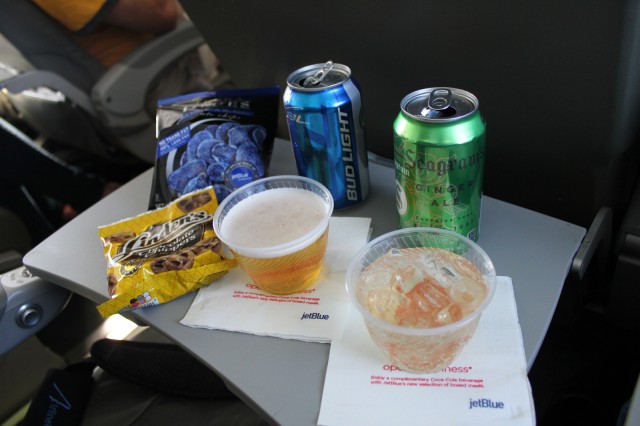
I paid for the beer, but everything else was free and good.
Jetblue offers complimentary non-alcoholic beverages and a nice selection of free snacks including, blue potato chips, chocolate chip cookies, animal crackers and more.
If you want something a bit more substantial, four different “EATUP boxes” are offered for $5.99 each. There is also a decent selection of alcoholic beverages for $6.99 each, except for Bud Light which goes for $5.99. Being a fiscally responsible travel blogger, I went for a few snack selections and the cheaper beer.
If you have money burning a hole in your pocket, you can also purchase a head pillow for $5.99 or a blanket for $4.99 that you get to keep. Make sure to bring a credit or debit cards, since JetBlue does not accept cash.
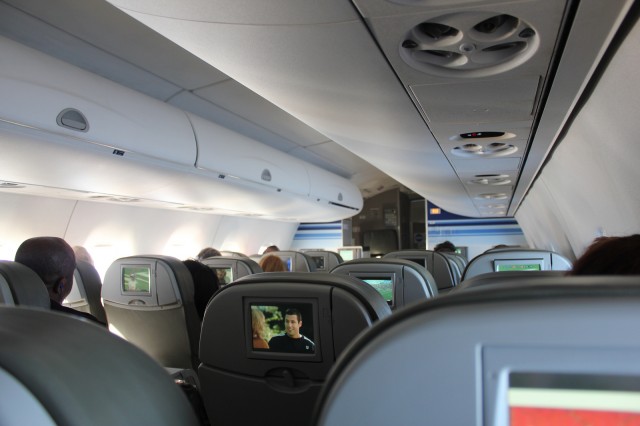
Each seat has its own TV with free entertainment.
Right after passing 10,000 feet, one flight attendant walked down the aisle selling food and non-food products. After that, another came through to get drink orders. I was confused when I got my beer and was not charged. Turns out that the flight attendant comes through at the end of the flight to do just one charge at the end — makes sense. However, on my next leg from Boston to Seattle, the flight attendant charged me right away for my food.
It was very easy for me to work on my laptop, while watching TV, which is not something I can say on other domestic products. It also helped that the seat next to me was empty.
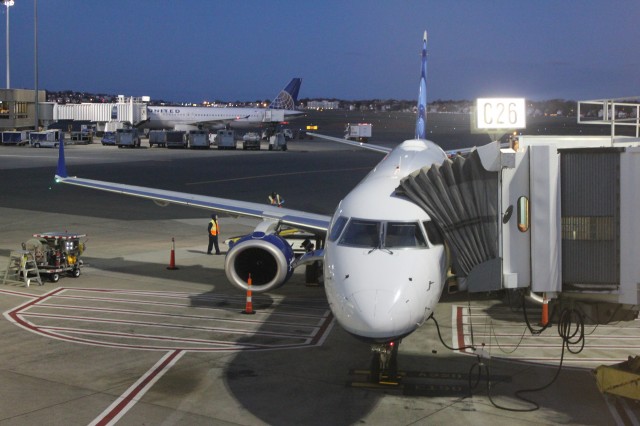
I had to take this photo in Boston, since NAS did not have any place to take a photo.
Since NAS offers pre-clearence for US Customs, I was able to quickly catch my connecting flight from Boston to Seattle without having to go through much hassel.
What would make the flight more enjoyable would be Wi-Fi. The airline is staying pretty quiet about their game plan, but are publicly stating that Wi-Fi should start showing up in JetBlue’s fleet starting in “early 2013.” JetBlue is planning to provide a Ka-band satelite solution through their own subsidiary, LiveTV.
I have to say that I really enjoyed the E-190/JetBlue combination and can’t wait for my next flight on either.
ADDITIONAL JETBLUE E-190 TRIP PHOTOS:
[nggallery id=31]
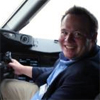 |
This story written by…
David Parker Brown, Editor & Founder. David started AirlineReporter.com in the summer of 2008, but has had a passion for aviation since he was a kid. Born and raised in the Seattle area (where he is currently based) has surely had an influence and he couldn’t imagine living anywhere else in the world.
@AirlineReporter | Flickr | YouTube |
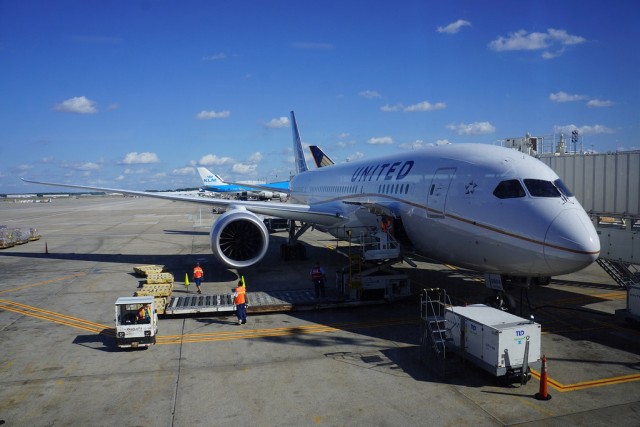
United Airline’s first Boeing 787 Dreamliner in Houston. Image by Chris Sloan / Airchive.com.
Chris Sloan, the man behind Airchive.com and is Executive Producer and Creator of Airport 24/7, was able to take the inaugural flight of United Airline’s first Boeing 787 Dreamliner. He agreed to share some of his photos and story with me and the rest of his story will be showing up on Airways Magazine in their February 2013 issues, hitting the shelves January 2nd. Here is his story, in his own words:
It is 5:00AM the morning of Sunday November 2, 2012 as I make my way over to Gate E5 at Houston’s George Bush Intercontinental Airport from a very quiet ticket counter, save for some journalists including Airways Magazine correspondent and director of social media, extraordinaire Jack Harty.
Despite the obscenely early hour, Jack and I are absolutely pumped with excitement and anticipation covering the story via live tweets, blogs, and for ’œAirways’. After foregoing a major development event, there is concern that this launch might be devoid of much of the pomp and circumstance of other launch flights, but this lack of showmanship, but this is doing little to dampen our enthusiasm for the inauguration of the first Boeing 787 to be operated by a U.S. carrier.
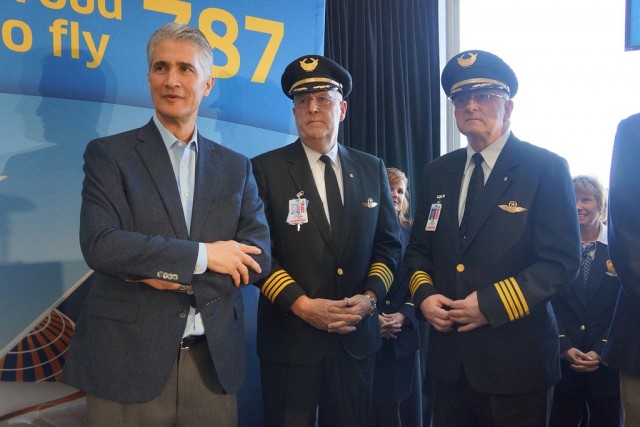
United’s CEO, Jeff Sismeck and flight crew stand on stage. Image by Chris Sloan / Airchive.com
On an optimistic note, Jeff Smisek, United’s President and CEO main theme is ’œThe 787 is worth the wait and all of our guests and members of the press are about to find out why’. Beyond all the usual groundbreaking features of the 787 normally mentioned: efficiency, pressurization, large windows, LED lighting, clean air, gust suppression technology, the humidified cabin, the ultra-quiet flight experience; Smisek gets some laughs when he says that ’œyou will all be very impressed with the lavatories’.
After the ribbon is cut, the boarding of the approximately 200 passengers begins promptly at 6:50AM. Flight 1116 from IAH-ORD is a normal operating flight with mostly paying passengers, some press, United high status customers, and of course a number of aviation enthusiasts. Many passengers are completely, but pleasantly surprised at the significance of this morning’s flight.
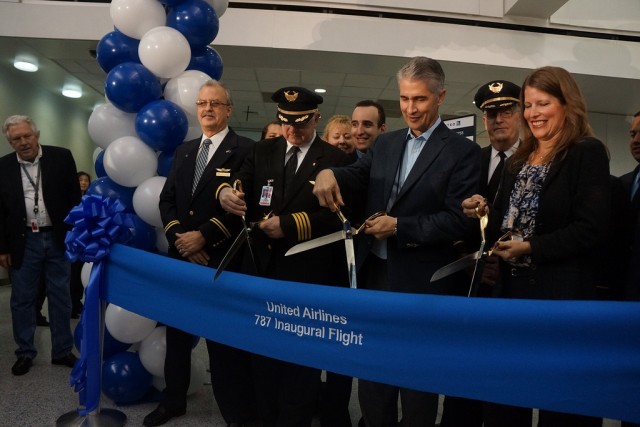
There have been many ribbons cut in the history of airline travel and this even was no different. Image by Chris Sloan / Airchive.com.
My first impressions of the cabin are positive. Though lacking the bar entry way of other airline’s 787, the entry through the gallery is still a major improvement over other aircraft, particularly with United’s blue LED boarding lighting program. I settled into my spacious seat, 6A in United BusinessFirst.
United initially chose to go big with a remarkable 8 flights scheduled on Day One involving 5 of United’s hubs: Houston Intercontinental, Newark, Chicago O’Hare, San Francisco, and Los Angles. These flights were to use 2 aircraft from the 787’s Houston base. United’s plan was to temporarily rotate the 787-8 through all of its domestic hubs that have a widebody service with domestic promotional and familiarization flights before it shifts to international operations on December 4th.
The journey to this day has been over 8 years in the making. United merger partner, Continental was the first airline in the America to placed an order for the Dreamliner shortly after the airliner was first offered to the market. Continental ordered 10 787-8s powered by the GEnx-1B.
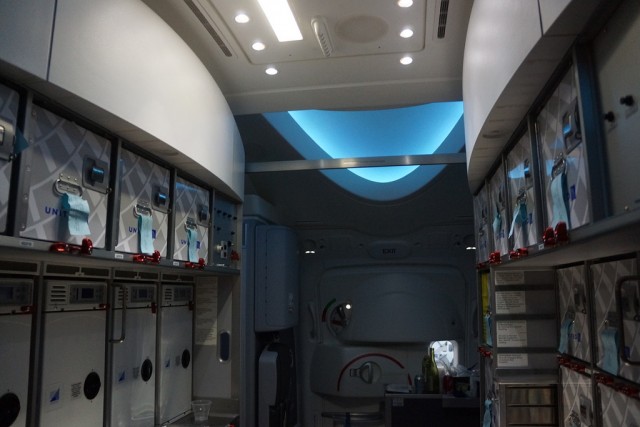
The entry way in United’s 787 is not as impressive as other 787’s, but nice none-the-less. Image by Chris Sloan / Airchive.com
The 787 would never fly under the Continental brand as United and Continental announced their merger in May 2010 and operationally on March 1, 2012. As everyone knows, the Continental Globe logo would carryover in the merger, replacing the tulip-a visual nod that this was in fact a merger of equals.
Ian Hankin, the Principal Engineer in Product Engineering points out in United PR releases that ’œgetting the 787 ready for regular operations has been more complex than for any plane to date, and the checklist of tasks runs many pages long. The different sections of the checklist correlate with various divisions throughout the company’. Hankin says ’œThis is due, in large part, to the advanced technology that makes up the plane’s structure (50 percent of which is composite materials) and the interior unique features.’
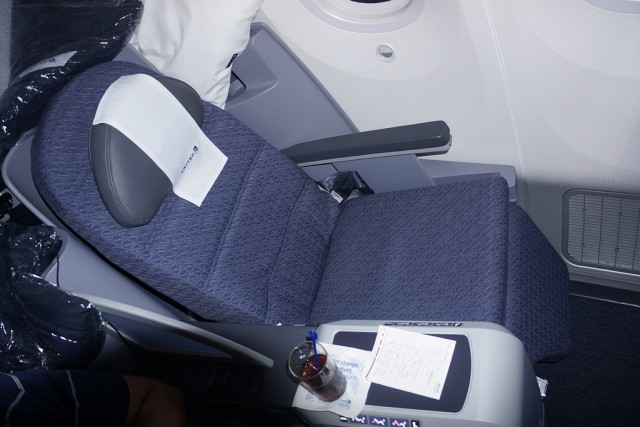
United’s BusinessFirst seats on the 787 Dreamliner. Image by Chris Sloan / Airchive.com.
United’s new BusinessFirst Cabin was initially to debut on the 787, but due to the delivery delays; it debuted on the 767 instead. It also does not feature the ’˜Dome’ dramatic entrance of some other airline’s 787s at door no. 2. Passengers enter through the galleys. Other than that, all the other Dreamliner features remain in place: the electronic dimmer buttons for the massive windows, high-arched ceiling, dynamic LED lighting, and enhanced ventilation and pressurization systems.
United’s 787 is configured with 36 seats in Business First 2-2-2 abreast with 60’ of pitch and 22’ in width. United has chosen a tighter seating layout then some 787 operators such as ANA and JAL opting for a 9 seats abreast in the economy cabins: 72 Economy Plus with 35-36’ of pitch and 18.3’ in width in a 3-3-3 abreast configuration, and 113 seats in Economy with 31’ pitch. On the return flight by the way, I sampled Premium Economy and was pleasantly surprised at how roomy it was. Panasonic’s eX2 provides the in-seat in-flight entertainment system on United’s 787 with Audio-Video on demand available at each seat. Power outlets are located at each seat in the business-class cabin and there are two for every three seats in the main cabin except for in the bulkhead rows where there are three outlets. Wi-Fi is not yet certified for the 787s. United is certainly not happy that their new flagship doesn’t have this capability, nor does any other 787 at this moment.
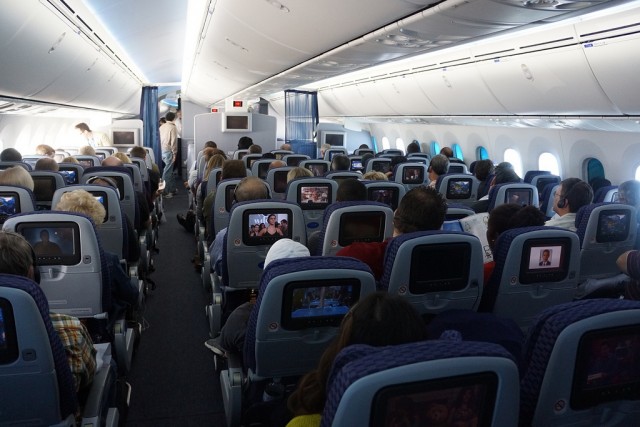
Economy is set up in a 3-3-3 format in United’s 787s. Image by Chris Sloan / Airchive.com.
According to the reservation agent, I was the first person to purchase a ticket on the first flight of Dreamliner service, the flight we are on today: United 1116. There was a lot of debate by #AvGeeks in the blogosphere and Twittersphere on whether this and the other November 4th flights would in fact be the first flights, or whether there would be special flights earlier. Even United’s press releases hinted at this possibility.
Unlike other airlines who chose splashy delivery ceremonies, United took delivery of their first 787 in a low-key manner on Sunday September 23rd. Rumors again swirled throughout the AvGeek world as to when the actual delivery would be and if there would be a large event. In the end, United chose to deliver their first 787 on Friday September 28, 011 from Boeing Field, instead of the usual Paine Field, as flight 7708 operating to Houston. There would be no fanfare upon departure. With 787 Fleet Standards Manager Captain Dave Lundy and Boeing 787 Assistant Fleet Manager Niels Olufsen at the controls, the journey between Seattle and Houston took approximately four hours departing at 9:56AM PST and landing at IAH at 3:56PM CST at an altitude of 41,000 feet. Upon arrival into United’s hub at stormy Houston George Bush Intercontinental Airport, the 787 was greeted by a water cannon salute before taxiing over to a hanger with excited employees waiting for it.
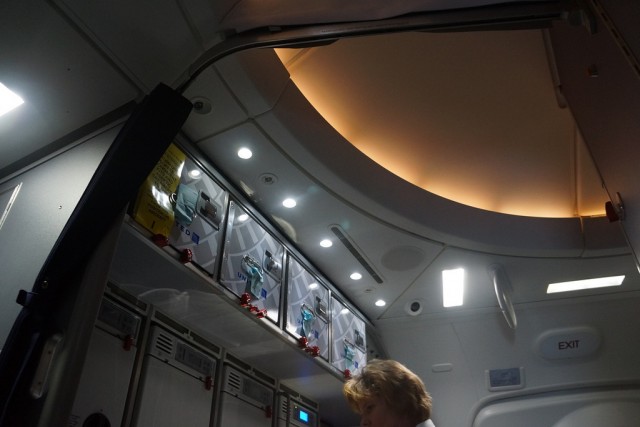
The LED lighting really sets the mood on the 787 Dreamliner. Image by Chris Sloan / Airchive.com.
This morning, Sunday November 4th there, are 4 flights operating the inaugural day: Our flight, 1116, is the first scheduled to depart early at 7:20AM with an arrival into Chicago O’Hare’s at 9:51AM. This plane is scheduled to turn-around and return back to Houston as flight 1510 after less than 2 hours on the ground in Chicago. Originally there were 8 flights scheduled, but now just 4. The remaining 2 flights of the day are: Houston-Los Angeles-Houston (IAH-LAX-IAH). United hubs at LAX, Newark, Cleveland, Denver, and Washington Dulles were scheduled to join the 787 Hub Tour throughout the month depending on the timing of the 2nd 787 being ready, with domestic revenue and familiarization flights continuing into early 2013.
We taxied out to IAH Runway 9, and at 7:27AM CST, began our very quick and very quiet 27-second take-off roll. With the aircraft only weighing 375,000 pounds (with 55,000 pounds of payload) out of a possible 502,000-pound max weight, Vr came at 140 knots in what was obviously a whisper-quiet take-off roll. A few seconds later we were airborne in a Northeastly direction to another round of applause, as is de rigueur in these occasions. We encountered a little chop in the climb to our FL41 cruising altitude, which gave a nice demonstration of the 787’s active aileron-driven gust suppression. The 787 is noticeably smoother than aircraft of its similar size such as the 767 and A330. Captain Starley came on the PA with some facts about the Dreamliner and today’s 2 hr, 9 min flight which would take us over to the east of Dallas, TX; Tulsa, OK; Springfield, MO; north of St. Louis, Joliet Illinois right into Chicago. We would fly at 504 knots and 580 mph. 19 minutes after take-off we leveled off at 41,000 feet.
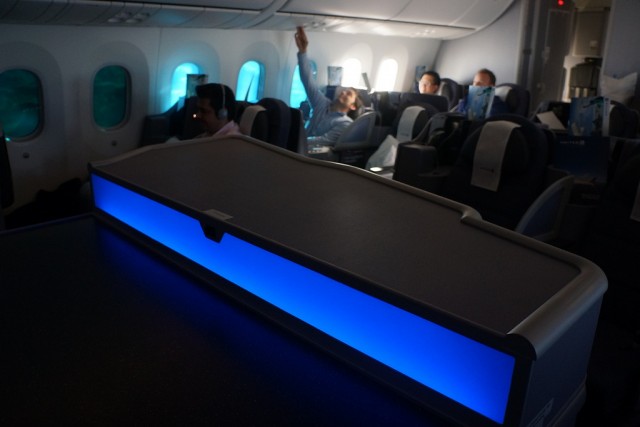
Lighting really provides a nice atmosphere in United’s 787 cabin. Image by Chris Sloan / Airchive.com.
At 7:54AM, United CEO Jeff Smisek came up from the back (yes, he was seated in Economy) and led a champagne toast, which was met with cheers. The seatbelt sign came-off briefly, albeit as the crew began their service. The LED lighting changed from the light blue cruising hue to a warm orange-ish tone, which supposedly accentuates the appearance of food. Apart from the commemorative Dreamliner souvenirs, first flight certificates, and cute custom 787 cookies, the service was fairly normal. In Business Class, we were offered tasty Egg McMuffins or cereal with fruit, yogurt, and croissants. In Economy, Buy-on-board meals were offered. The 8 Flight Attendants (11 FA’s are on international flights) who had specially bid this trip conducted a gracious, proud service while navigating around what had turned into an airborne party.
After a quick breakfast, I had an opportunity to checkout the comfortable new lie-flat seats that were very comfortable and a big improvement over the previous BusinessFirst product. If there is any complaint, it’s that the AC power and USB connections are located rather inconveniently behind the passenger at the back of the seat. The Panasonic eX2 in-flight-entertainment system is chock-a-block full of music and video on demand, games, and a high-resolution airshow moving map, but sadly United’s famous ’œChannel 9’ for listening to the pilot’s communications is missing. The IFE, while excellent, isn’t as cutting edge as some other’s but in United’s defense, it was state-of-the-art when initially ordered. My favorite, and previously unreported feature, was the smartly lit buffet / bar at the front of the forward BusinessFirst cabin. United’s seems somehow aesthetically better designed and more properly scaled than the ’œgalley bars’ on other 787s.
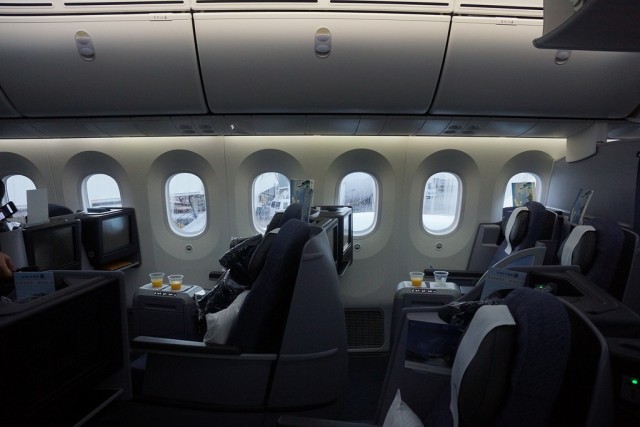
BusinessFirst seats in United’s Boeing 787 Dreamliner. Image by Chris Sloan / Airchive.com
With 40 minutes left in the flight, the air brakes came up and we began our initial descent. Captain Starley announced that we were burning an astoundingly low 9,000 pounds of fuel per hour, and that with 55 mph of tailwind were now flying at Mach .833. He termed the 787 as ’œa generational step forward’, yet ’œIt still flies like a Boeing and it’s a ’˜pilot’s airplane’’. Starley, who has flown commercially since 1973 and has flown everything from DC-8s to 777s, has the experience for his perspective to matter. Later to me, He offered that the 787s enhanced fuel efficiency is not only good for the environment and passengers, but it also equals job security for airline jobs as it allows airlines to fly more profitably at lower costs.
Captain Starley turned the 787 auto-pilot off at 4,000 feet and at 9:36AM CST executed a perfect ’œgrease job’ of a landing onto ORD’s runway 10, to cheers and clapping. We quickly exited the runway and as we taxied the first words heard over the PA, were ’œIt’s A Dream Come True’, and yes you guessed it: there was more applause. What’s an inaugural flight without the obligatory Grand Finale: ’œThe Water Cannon Salute’. These salutatory moments never get old as our 787 was given a bath from both sides of the jet. At United’s Gate C20, I deplaned right behind Jeff Smisek to a line of well-wishers and press. His remarks said it all: ’œAwesome! Just Awesome!’

United’s first two 787’s at IAH. Photo by Chris Sloan / Airchive.com.
After a short gate ceremony, United flight 1510 boarded for its on-time departure to Houston. This more subdued and conventional flight would be nearly devoid of all the ceremony of the inaugural flight. In fact, apart from being on the newest airliner of the 21st Century, it felt utterly normal. The Dream had become reality and that was the point.
See many more photos of Chris’ adventure on United’s 787 on his site Airchive.com.



























